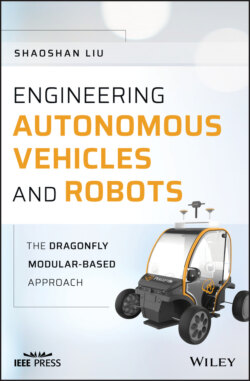Читать книгу Engineering Autonomous Vehicles and Robots - Shaoshan Liu - Страница 32
2.3.1 FlexRay Topology
ОглавлениеUnlike CAN, FlexRay supports multiple topologies, including simple multi-drop passive connections as well as active star connections for more complex networks. Depending on a vehicle's layout and level of FlexRay usage, selecting the right topology helps designers optimize cost, performance, and reliability for a given design.
Multi-drop bus: FlexRay is commonly used in a simple multi-drop bus topology that features a single network cable run that connects multiple ECUs together. This is the same topology used by CAN and is familiar to OEMs, making it a popular topology in first-generation FlexRay vehicles. In this topology, each ECU can “branch” up to a small distance from the core “trunk” of the bus. The ends of the network have termination resistors installed that eliminate problems with signal reflections. Because FlexRay operates at high frequencies, up to 10 Mbps compared with CAN's 1 Mbit, FlexRay designers must take care to correctly terminate and lay out networks to avoid signal integrity problems. The multi-drop format also fits nicely with vehicle harnesses that commonly share a similar type of layout, simplifying installation and reducing wiring throughout the vehicle.
Star network: The FlexRay standard supports “star” configurations which consist of individual links that connect to a central active node. This node is functionally similar to a hub found in PC ethernet networks. The active star configuration makes it possible to run FlexRay networks over longer distances or to segment the network in such a way that makes it more reliable should a portion of the network fail. If one of the branches of the star is cut or shorted, the other legs continue functioning. Since long runs of wires tend to conduct more environmental noise, such as electromagnetic emissions from large electric motors, using multiple legs reduces the amount of exposed wire for a segment and can help increase noise immunity.
Hybrid network: The bus and star topologies can be combined to form a hybrid topology. Future FlexRay networks will likely consist of hybrid networks to take advantage of the ease-of-use and cost advantages of the bus topology while applying the performance and reliability of star networks where needed in a vehicle.
